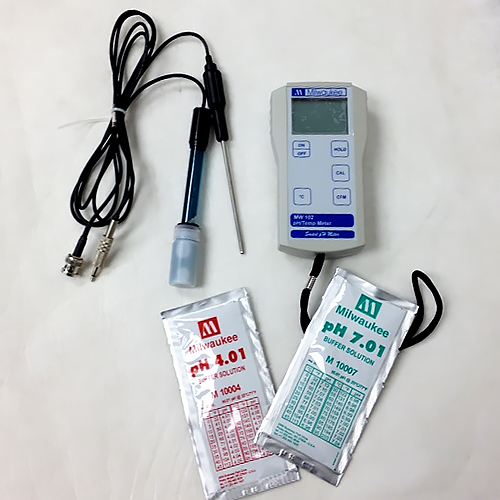by The Beverage People
Measuring pH requires some understanding of the equipment in order to measure correctly. Furthermore, care of the electrode is an important part of pH meter ownership. Let’s look at the list of items needed for proper usage and care of a pH meter, then discuss the operations and maintenance activities as well.
Full list of items needed for pH usage and maintenance:
- pH meter
- pH calibration buffers – usually 4.0 and 7.0 for beverage related usage.
- Electrode storage solution
- Distilled water
- Cleaners: sodium percarbonate is a great choice. Optionally, also a glass cleaner, and perhaps neutral alcohol.
Using the pH meter
Calibration is required
Accurate pH reading cannot be accomplished unless the pH meter is calibrated. A pH electrode glass membrane changes over time, as does the calibration of the voltmeter. Before using your pH meter each day, perform a fresh calibration, according to the device instructions, with pH calibration buffers near the pH range in which you intend to be testing. For example, if you are testing a wine expected to be in the 3.5-4.0 pH range, you should certainly have 4.0 pH calibration buffer on hand. Some pH meters allow for 2-point calibration.
Ensure the batteries are viable. Low batteries often lead to improper meter performance.
Cleaning the electrode
Most pH electrodes are made with a glass bulb which is made of a thin membrane of a special kind of glass that actually does the job of responding to the pH of the solution. It can sometimes become dirty and poorly responsive. Here are instructions to clean the electrode based on the type of material that needs removal.
Protein deposits and most organic soiling can be removed by soaking in a Sodium Percarbonate solution made of ¼ tsp Sodium Percarbonate in 1 cup of water at 140 °F for 5-10 mins.
Mineral deposits may be removed by soaking in a glass cleaning detergent solution, such as most hand dishwashing detergents, for 15 mins.
Grease and oil deposits may be removed by rinsing the electrode in a neutral alcohol solution.
Electrode storage – KEEP IT HYDRATED
For longest life of the electrode, the electrode should be kept hydrated at all times. The best choice is to use an electrode storage solution made with KCl. If that is not available, using a 4.0 pH buffer solution is a reasonable alternative.
If your electrode is dry, rehydrate the sensing tip by soaking the bulb and junction in an electrode storage solution for at least one hour, ideally overnight. Storing your electrode in storage solution also improves its life span and performance.
Troubleshooting an old electrode
Is the pH electrode is acting sluggish, erratic and is difficult to calibrate?
The life of an electrode is generally 1-4 years. If values appear to drift, leave the electrode in the pH 4 calibration solution for 30 minutes. If that does not return the electrode to normalcy, try these cleaning and reconditioning recommendations.
Reconditioning and cleaning of pH electrodes
Even in normal use and storage, performance of pH electrodes may show deterioration over time, which typically shows up as erratic or sluggish electrode readings, and/or difficulty calibrating. Assuming the meter itself is working then there are two main causes for this:
- Clogging of the reference junction (most likely). A pH electrode’s junction is the porous communication point between the electrolyte solution in the reference electrode and the sample itself.
- Fouling of the glass membrane (happens occasionally, or after prolonged service).
The following procedures will often provide renewed stability and pH sensitivity. If the electrode cannot be restored by one of these methods, it needs to be replaced.
Unblocking the reference junction: The reference electrode junction is usually the problem when the electrode can’t calibrate in its expected ranges.
- Soak electrode in hot (NOT boiling!) water, about 140 °F, for 5 – 10 mins. Allow to cool to room temperature then place in pH 4 reference solution for 5 minutes. Try to recalibrate. If this does not work, try remedy 2.
- Place the pH electrode into the pH storage solution at 140 °F and allow electrode and solution to cool to room temperature, then place in pH 4 reference solution for 5 minutes. Try to recalibrate. If this doesn’t work, try remedy 3.
- Soak in a Sodium Percarbonate (AKA Proxycarb) solution for made of ¼ tsp Sodium Percarbonate in 1 cup of water at 140 °F for 5-10 mins. Rinse with DI water, then place in pH 4 reference solution for 5 minutes. Try to recalibrate.

